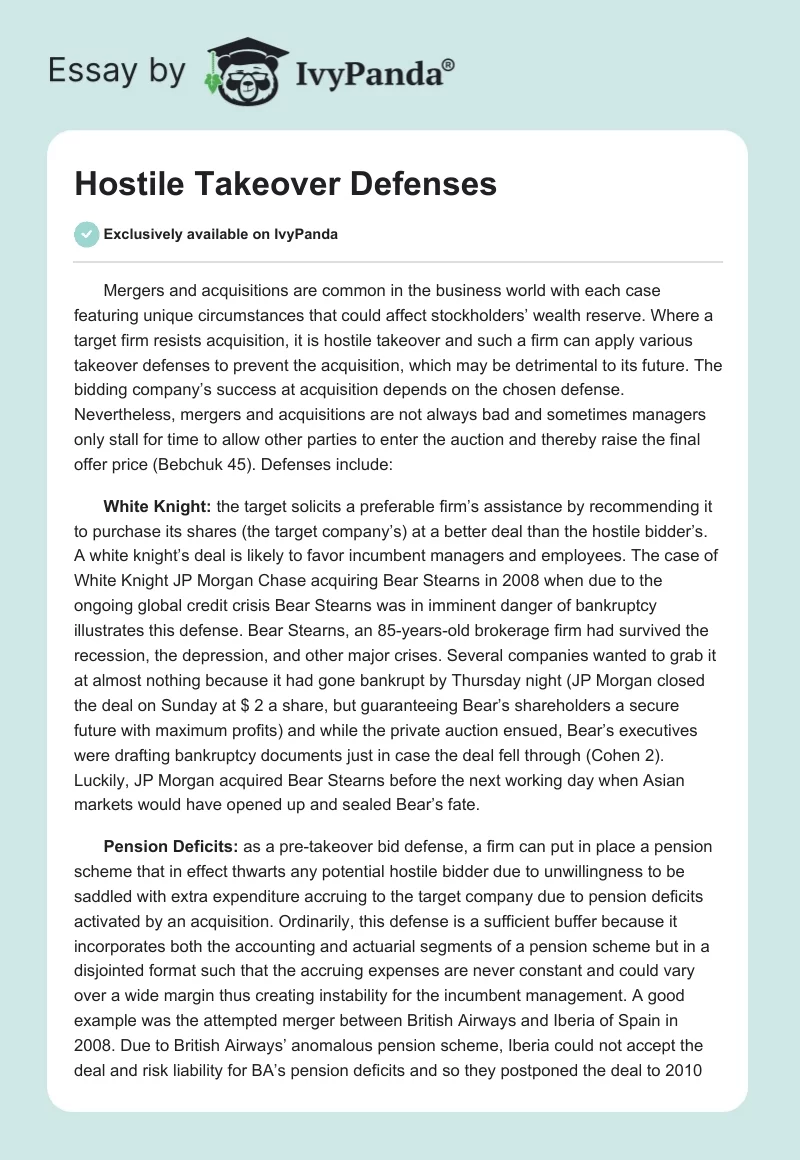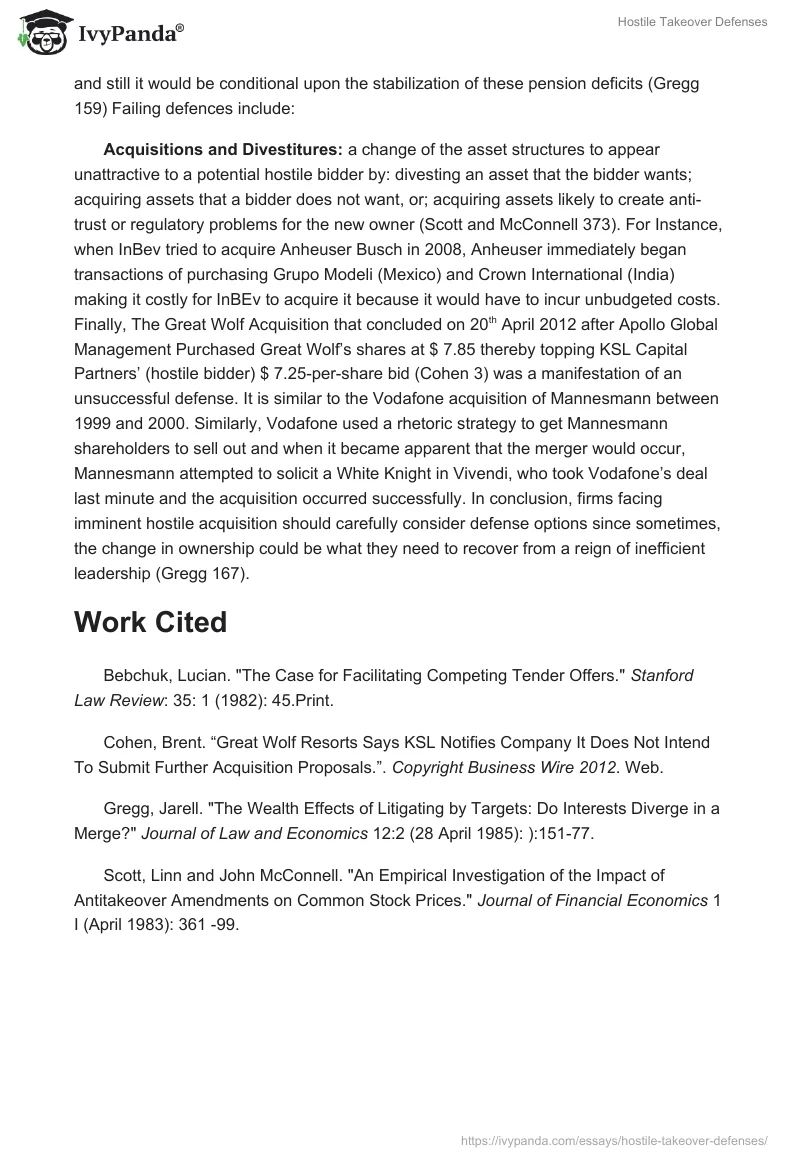Mergers and acquisitions are common in the business world with each case featuring unique circumstances that could affect stockholders’ wealth reserve. Where a target firm resists acquisition, it is hostile takeover and such a firm can apply various takeover defenses to prevent the acquisition, which may be detrimental to its future. The bidding company’s success at acquisition depends on the chosen defense. Nevertheless, mergers and acquisitions are not always bad and sometimes managers only stall for time to allow other parties to enter the auction and thereby raise the final offer price (Bebchuk 45). Defenses include:
White Knight: the target solicits a preferable firm’s assistance by recommending it to purchase its shares (the target company’s) at a better deal than the hostile bidder’s. A white knight’s deal is likely to favor incumbent managers and employees. The case of White Knight JP Morgan Chase acquiring Bear Stearns in 2008 when due to the ongoing global credit crisis Bear Stearns was in imminent danger of bankruptcy illustrates this defense. Bear Stearns, an 85-years-old brokerage firm had survived the recession, the depression, and other major crises. Several companies wanted to grab it at almost nothing because it had gone bankrupt by Thursday night (JP Morgan closed the deal on Sunday at $ 2 a share, but guaranteeing Bear’s shareholders a secure future with maximum profits) and while the private auction ensued, Bear’s executives were drafting bankruptcy documents just in case the deal fell through (Cohen 2). Luckily, JP Morgan acquired Bear Stearns before the next working day when Asian markets would have opened up and sealed Bear’s fate.
Pension Deficits: as a pre-takeover bid defense, a firm can put in place a pension scheme that in effect thwarts any potential hostile bidder due to unwillingness to be saddled with extra expenditure accruing to the target company due to pension deficits activated by an acquisition. Ordinarily, this defense is a sufficient buffer because it incorporates both the accounting and actuarial segments of a pension scheme but in a disjointed format such that the accruing expenses are never constant and could vary over a wide margin thus creating instability for the incumbent management. A good example was the attempted merger between British Airways and Iberia of Spain in 2008. Due to British Airways’ anomalous pension scheme, Iberia could not accept the deal and risk liability for BA’s pension deficits and so they postponed the deal to 2010 and still it would be conditional upon the stabilization of these pension deficits (Gregg 159) Failing defences include:
Acquisitions and Divestitures: a change of the asset structures to appear unattractive to a potential hostile bidder by: divesting an asset that the bidder wants; acquiring assets that a bidder does not want, or; acquiring assets likely to create anti-trust or regulatory problems for the new owner (Scott and McConnell 373). For Instance, when InBev tried to acquire Anheuser Busch in 2008, Anheuser immediately began transactions of purchasing Grupo Modeli (Mexico) and Crown International (India) making it costly for InBEv to acquire it because it would have to incur unbudgeted costs. Finally, The Great Wolf Acquisition that concluded on 20th April 2012 after Apollo Global Management Purchased Great Wolf’s shares at $ 7.85 thereby topping KSL Capital Partners’ (hostile bidder) $ 7.25-per-share bid (Cohen 3) was a manifestation of an unsuccessful defense. It is similar to the Vodafone acquisition of Mannesmann between 1999 and 2000. Similarly, Vodafone used a rhetoric strategy to get Mannesmann shareholders to sell out and when it became apparent that the merger would occur, Mannesmann attempted to solicit a White Knight in Vivendi, who took Vodafone’s deal last minute and the acquisition occurred successfully. In conclusion, firms facing imminent hostile acquisition should carefully consider defense options since sometimes, the change in ownership could be what they need to recover from a reign of inefficient leadership (Gregg 167).
Work Cited
Bebchuk, Lucian. “The Case for Facilitating Competing Tender Offers.” Stanford Law Review: 35: 1 (1982): 45.Print.
Cohen, Brent. “Great Wolf Resorts Says KSL Notifies Company It Does Not Intend To Submit Further Acquisition Proposals.”. Copyright Business Wire 2012. Web.
Gregg, Jarell. “The Wealth Effects of Litigating by Targets: Do Interests Diverge in a Merge?” Journal of Law and Economics 12:2 (28 April 1985): ):151-77.
Scott, Linn and John McConnell. “An Empirical Investigation of the Impact of Antitakeover Amendments on Common Stock Prices.” Journal of Financial Economics 1 I (April 1983): 361 -99.




